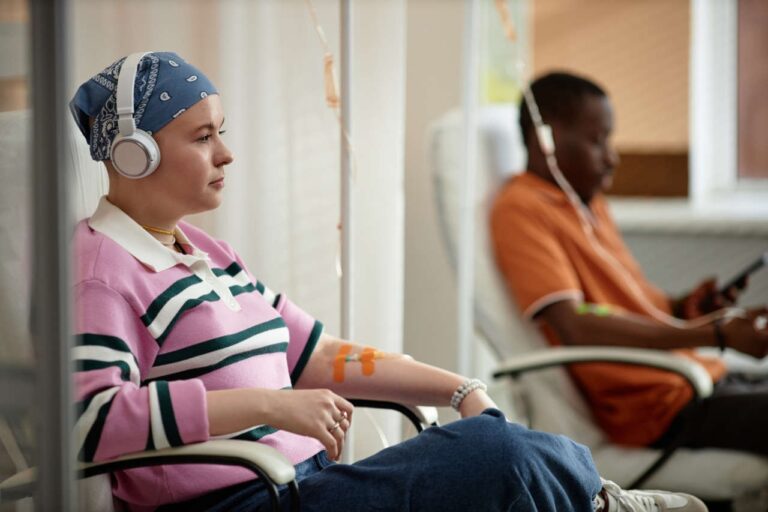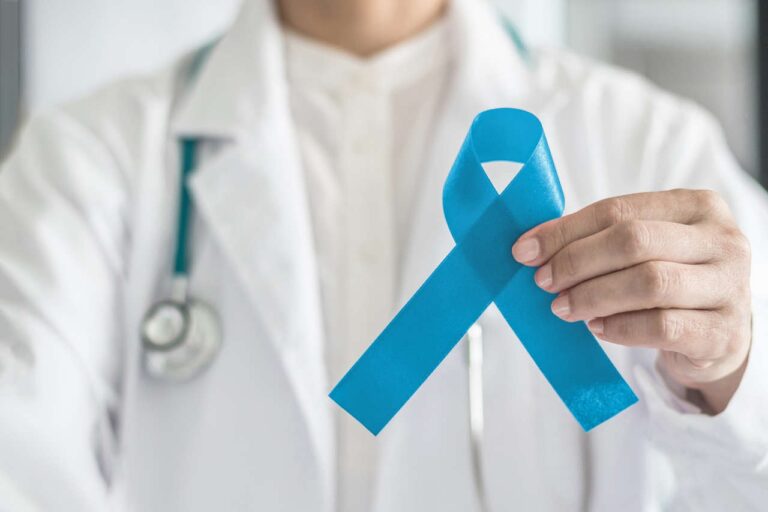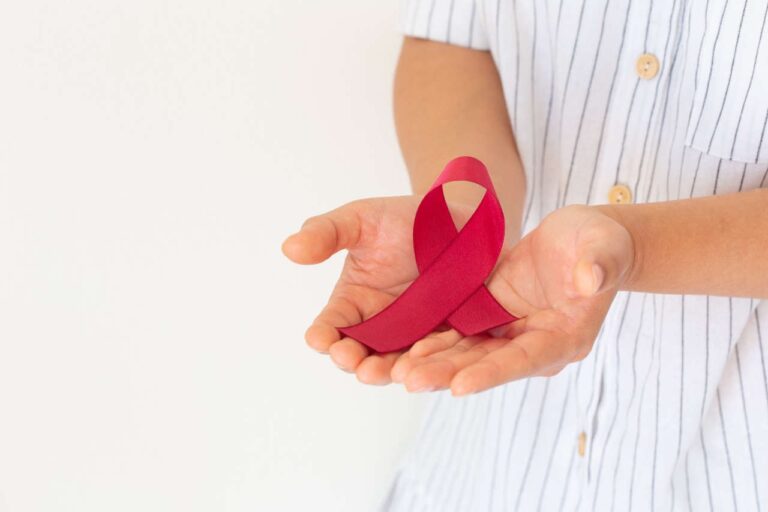
Every year, millions of people undergo chemotherapy to treat cancer. Although chemotherapy can be lifesaving, it comes with many side effects. One such side effect of chemotherapy is that it can lower the number of white blood cells in your body. White blood cells fight off foreign substances, such as viruses and bacteria. So, a decrease in the number of white blood cells can increase your risk of infections.
Obtenga asistencia financiera
Fortunately, modern medicines can help manage this side effect and protect you from infections during your cancer treatment. One such medication is Fylnetra (pegfilgrastim-pbbk). You may be wondering what Fylnetra is, how it works, and what the side effects are. In this article, we’ll explore everything you need to know about Fylnetra.
What Is Fylnetra?
Fylnetra (pegfilgrastim-pbbk) is a prescription medicine used to prevent infections in patients receiving chemotherapy that may lower their white blood cell (neutrophil) counts. It is a biosimilar to Neulasta (pegfilgrastim). This means that there is no meaningful clinical difference between Fylnetra and Neulasta, but the price of Fylnetra is less.
Amneal Pharmaceuticals LLC developed Fylnetra, and the FDA first approved it on May 26, 2022 [1]. It belongs to a class of drugs called colony-stimulating factors (CSF). CSFs help stimulate your bone marrow to produce more white blood cells (neutrophils), which play a crucial role in fighting infections.
By helping your body make more white blood cells, Fylnetra reduces the risk of infections that often come with certain chemotherapy treatments. You can receive this drug as a subcutaneous injection (an injection under the skin).
¿Para qué se utiliza?
Fylnetra (pegfilgrastim-pbbk) is an FDA-approved medication used for the following two purposes [2]:
Prevention of infection in cancer patients receiving myelosuppressive chemotherapy who have a significant risk of febrile neutropenia: Fylnetra can reduce the risk of infection in patients with non-myeloid cancers who are receiving myelosuppressive chemotherapy (cancer treatments that can significantly lower white blood cell counts). By boosting white blood cell production, Fylnetra helps protect the body against infections during chemotherapy.
Improvement of survival in patients with Hematopoietic Subsyndrome of Acute Radiation Syndrome (ARS): This is a condition caused by acute exposure to myelosuppressive doses of radiation, which damages the bone marrow and reduces your ability to produce blood cells and fight infection. Fylnetra can increase survival in these patients by stimulating the bone marrow, helping patients rebuild their white blood cell levels.
How Does Fylnetra Work?
Chemotherapy targets rapidly dividing cells to destroy cancer cells. However, in the process, chemotherapy can also harm healthy cells, including those in the bone marrow, where blood cells are produced. This damage can lead to a drop in neutrophils (a type of white blood cell). When neutrophil levels are too low, you are more prone to infections.
Fylnetra contains pegfilgrastim. It is a man-made version of a natural protein in the body called granulocyte colony-stimulating factor (G-CSF). Fylnetra works by stimulating the bone marrow to make more neutrophils [2].
Unlike some similar medications (e.g., filgrastim), Fylnetra stays in your body for a longer time. Because of this, you need to take it only once per chemotherapy cycle.
Fylnetra Side Effects

Like any other medication, Fylnetra can also cause some side effects. Some of these side effects are mild and temporary, while others are severe and require immediate medical attention. Here are some of the side effects of this medication [2][3]:
Efectos secundarios comunes
Here are some common side effects of Fylnetra:
- Dolor de huesos
- Dolor en brazos o piernas
- Dolor de espalda
- Fatiga
These side effects are usually mild and go away within a few days. However, if these symptoms persist or worsen, consult your doctor.
Habla con un especialista
Acerca de la asistencia para copagosEfectos secundarios graves
In rare cases, Fylnetra can cause some serious side effects. If you encounter any of these severe side effects, contact your doctor immediately. Here are some of those serious side effects:
Fatal Splenic Rupture: Fylnetra can cause your spleen to become large, which can rupture and cause death. Symptoms of an enlarged spleen include pain in the left upper abdomen or shoulder tip.
Reacciones alérgicas graves: You may experience symptoms like rashes, swelling, shortness of breath, or dizziness after injection. Discontinue permanently if you experience allergic reactions.
Síndrome de dificultad respiratoria aguda (SDRA): This serious lung condition can cause shortness of breath, fever, and fast breathing.
Fatal Sickle Cell Crises: In patients with sickle cell disease, Fylnetra can cause a severe sickle cell crisis (a painful episode). Discontinue use if a sickle cell crisis occurs.
Aortitis (Inflammation of the Aorta): Symptoms include fever, fatigue, and pain in the chest, back, or abdomen.
Problemas renales: Fylnetra can damage your kidneys. Symptoms include dark urine, swelling in your face or legs, and little to no urination.
Síndrome de fuga capilar (CLS): This condition occurs when fluid and proteins leak out of your small blood vessels (capillaries) into surrounding tissues. This leads to low blood pressure, low levels of albúmina in your blood, swelling, fatigue, shortness of breath, and diarrhea.
Please note that this is not a complete list of all possible side effects. Always consult your doctor if you experience any unusual symptoms.
Dosificación y administración
Fylnetra is available as a single-dose prefilled syringe, which is given subcutaneously (under the skin). Before using, inspect the syringe, and if you see any discoloration or particulates, discard it. The usual recommended dosage is given below [2]:
For patients with cancer receiving myelosuppressive chemotherapy: The recommended dose is 6 mg, administered subcutaneously (under the skin) once per chemotherapy cycle. Do not administer Fylnetra within 14 days before or 24 hours after receiving cytotoxic chemotherapy.
For patients acutely exposed to myelosuppressive doses of radiation: These patients will receive two 6 mg doses one week apart. The first dose is given as soon as possible after suspected or confirmed radiation exposure, and the second dose is given one week later.
Fylnetra Cost
The price of Fylnetra is approximately $2,450 per syringe [4]. However, the actual cost will depend on your insurance plan, location, and the pharmacy you visit. You can apply for the Amneal Patient Assistance Program [5]. If you are eligible, you can receive free medication for up to a year.
Preguntas frecuentes
1. Can I use Fylnetra during pregnancy or breastfeeding?
There is still not enough data available to establish if usage during pregnancy is safe or not [2]. Therefore, you should only use Fylnetra during pregnancy or breastfeeding if your doctor thinks that the benefits outweigh the risks.
2. Is it safe for children?
Sí. The use of Fylnetra is safe and approved for pediatric patients. Scientific studies have shown no significant differences in safety between adults and children.
3. How is Fylnetra different from Neulasta?
Fylnetra is a biosimilar to Neulasta. This means that it is highly similar, but not identical, to the active ingredient in Neulasta (pegfilgrastim) and both provide the same clinical benefits and safety profile. However, it is generally less expensive.
REFERENCIAS:
- Drugs@FDA: FDA-Approved drugs. (n.d.). FDA. https://www.accessdata.fda.gov/scripts/cder/daf/index.cfm?event=overview.process&varApplNo=761084
- HIGHLIGHTS OF PRESCRIBING INFORMATION. (2025). https://fylnetra.us/wp-content/uploads/2025/04/FylnetraUSPI-April2025.pdf
- Admin. (2025, June 4). About Fylnetra®. Fylnetra®. https://fylnetra.us/#important-safety-information
- Fylnetra Prices, Coupons, Copay Cards & Patient Assistance. (n.d.). Drugs.com. https://www.drugs.com/price-guide/fylnetra
- The Amneal Patient Assistance Program – Amneal Pharmaceuticals. (2025, October 23). Amneal Pharmaceuticals. https://amneal.com/about/responsibility/patient-assistance-programs/













